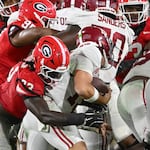MIRAMAR BEACH, Fla. — Greg Sankey noted the irony in the Bob Dylan song he quoted near the start of his SEC commissioner tenure in 2015.
“There’s been a lot, obviously, that’s taken place over the last decade,” said Sankey, who recently completed his ninth year leading the conference. “Looking back to my first media days presentation (in 2015), I was quoting Bob Dylan at the time ….
“The Times They Are a-Changin, and that was an understatement, it turns out — that was the understatement of the decade.”
SEC presidents, chancellors, athletic directors and coaches are gathering at the Hilton Sandestin Golf Resort & Spa this week to discuss several pressing and complex issues that have arisen in collegiate sports.
College athletics have taken a turn from an amateur model to what amounts for pay-for-play, with little structure or governance on transfer limitations and NIL and collective dealings.
“There’s no better time to be a student-athlete than right now in the history of college sports,” Sankey pointed out. “They have freedom of movement, they have freedom to access name image and likeliness opportunities — it’s a pretty good existence … "
But it is certainly not one without the potential for litigation.
Sankey was abrupt when asked about the pending lawsuit involving Georgia transfer quarterback Jaden Rashada suing the University of Florida and coach Billy Napier, which involves accusations the player was shorted of millions of dollars agreed upon NIL money.
“I”m not a fan of lawsuits, that’s what I think,” Sankey said, asked his opinion of what the lawsuit suggests about the collegiate sports landscape.
“It’s not the only lawsuit involving a coach in the last year. It won’t be the last. We have a legal system and people have a right to pursue what they view as grievances.”
Indeed, the earth is shifting beneath collegiate sports daily with no end in sight after the NCAA and Power 5 conferences agreed to pay more than $2.7 billion in damages over 10 years to past and current athletes.
RELATED: Josh Brooks discusses potential impact of NCAA landmark settlement
ESPN reported the parties have also agreed to annual payments of about $20 million of shared revenue with its athletes.
Sankey noted how there is nothing settling about the landmark settlement.
“There is no aftermath, we are living after an announcement last week about a judgment … a settlement agreement between plaintiffs, council and the defendants,” Sankey said. “We are in that process … that process will be many months, subject to court review and subject to entire legal process.”
In others words, there’s much, much more to come with questions about congressional oversight, NCAA authority and the potential for a collective bargaining agreement, among other things.
Fans will, however, have a better grasp of college football game times as the SEC’s television partnership has been modified.
“By mid-June we’ll announce all of our early window kickoff times —that’s the noon and 1 eastern (time) window,” Sankey said, explaining how some afternoon and evening contests will still be subject to “flex” scheduling, which allows for kick times to shift 6 or 12 days before the games based on the network’s scheduling strategy.
Texas and Oklahoma become active members of the SEC, adding two more active voices to the spring meeting conversations, as the league grows from 14 to 16 teams.
Sankey said there will also be more discussion on how schools approach player availability reports— in terms of how information is managed — in light of the growing amount of legalized gambling, and the challenges and pressures that puts on student-athletes.
“When you start to see the numbers of dollars being bet on legalizes sports gambling or on college sports — not just football, but mens’ and women’s basketball, volleyball and baseball — all those catch your attention,” Sankey said.
“The lives of young people in colleges versus the lives of professional athletes are very different, as far as exposure to people,” he said.
“There’s a lot more people around our programs …. sitting in classes isn’t something that happens to an NFL or Major League Baseball participant, but it happens on a daily basis to a college athlete.”
SEC football and basketball head coaches will appear on Tuesday at the spring meetings, which will run through Thursday.
To Sankey’s point, times are indeed changing, and collegiate sports leaders find themselves challenged to find ways to catch up.
Closer look at Georgia athletics

